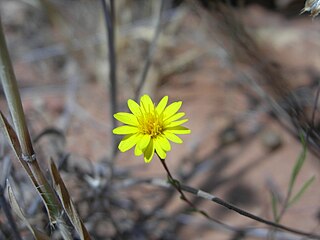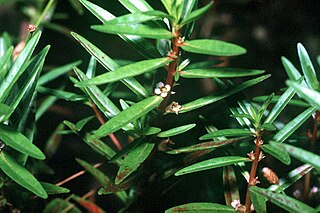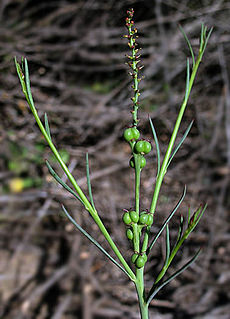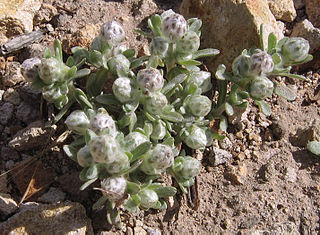
Daucus pusillus is a species of wild carrot known by the common names American wild carrot and rattle-snake-weed. Its Latin name means "little carrot", or "tiny carrot". It is similar in appearance to other species and subspecies of wild carrot, with umbels of white or pinkish flowers.

Rigiopappus is a genus of North American plants in the tribe Astereae within the family Asteraceae. It is closely related to genus Pentachaeta.

Collinsia parviflora is a species of flowering plant in the family Plantaginaceae known by the common names maiden blue eyed Mary and small-flowered collinsia.

Layia is a genus of flowering plants in the family Asteraceae known generally as tidy tips, native to western North America. Several are California endemics.
Layia pentachaeta is a species of flowering plant in the family Asteraceae known by the common name Sierra tidytips, or Sierra layia.

Chenopodium atrovirens is a species of flowering plant in the amaranth family known by the common names pinyon goosefoot and dark goosefoot.
Chenopodium desiccatum is a species of flowering plant in the family Amaranthaceae known by the common names aridland goosefoot and slimleaf goosefoot.

Pentachaeta lyonii, the Lyon's pentachaeta or Lyon's pygmydaisy, is an annual plant in the family Asteraceae. It is endemic to southern California, where it is now known only from a few areas on the heavily developed coastline of Los Angeles and Ventura Counties. It is a federally listed endangered species.

Sedella is a small genus of annual flowering plants in the family Crassulaceae. There are approximately 7 species, all native to California, United States, one with a distribution extending into Oregon. These are petite succulent plants growing a few centimeters tall and bearing tiny yellowish or brownish flowers. Mock stonecrop is a common name for these plants.

Pentachaeta aurea is a species of flowering plant in the aster family known by the common names golden-rayed pentachaeta, golden chaetopappa, and golden leastdaisy. It is native to southern California, where it grows in the San Gabriel and San Bernardino Mountains and the Peninsular Ranges, and northern Baja California. It is an annual herb with a hairy stem reaching a maximum height near 36 centimeters from a slender taproot. The narrow linear leaves are up to 5 centimeters long but only a few millimeters wide and may be very hairy. The inflorescence is a solitary flower head, with up to 22 heads per plant. The flower head bears many yellow, brownish, or whitish ray florets 3 to 12 millimeters long, and has a center of many five-lobed yellow to reddish disc florets. The fruit is an achene tipped with a pappus of bristles.

Pogogyne serpylloides is a species of flowering plant in the mint family known by the common names thymeleaf mesamint and thymeleaf beardstyle. It is endemic to central California, where it grows in grassy habitat in coastal and inland mountain ranges and foothills. It is a petite aromatic annual herb growing decumbent or upright, often reaching no more than a centimeter in height even when erect in form, sometimes larger. The slender stem is sometimes branched. The inflorescence is a series of rounded, headlike clusters, with occasional single flowers emerging at leaf axils. The tiny tubular flower is 2 to 5 millimeters long and has a lobed, lipped mouth. It is lavender in color, sometimes with faint white markings in the mouth.

Ranunculus hebecarpus is a species of buttercup known by the common name delicate buttercup. It is native to western North America, including several of the western United States and Baja California, where it grows in grassland, woodland, and chaparral habitat. It is an annual herb producing a slender, hairy stem a few centimeters high or up to 30 centimeters tall. The hairy leaves are borne on long petioles. Their blades are deeply lobed or divided into three leaflets, often with toothed or lobed edges. Flowers have 3 to 5 tiny yellow petals just 1 or 2 millimeters long studded on the bulbous nectary; some flowers lack petals. The plant is most easily identified in its fruiting stage, when the infructescence is a spherical cluster of several tiny disc-shaped achenes with compressed, bristly sides.

Rotala ramosior is a species of flowering plant in the loosestrife family known by the common name lowland rotala. This aquatic or semiaquatic plant is native to North America, where it grows in lakes, streams, and irrigation ditches. The branching stems of the plant grow to about 40 cm long. Leaves are decussate, arranged oppositely in perpendicular pairs along the stems. The leaves are linear to lance-shaped to oval and up to 5 cm long. Flowers occur singly in leaf axils. Each has triangular sepals with long, narrow appendages and usually four tiny white petals in shades of pink to white. This plant is sometimes grown in aquariums.
Sagina decumbens is a species of flowering plant in the family Caryophyllaceae known by the common names trailing pearlwort and western pearlwort. It is native to several areas of North America, where it can be found in many types of habitat. It is a small annual herb producing a threadlike green or purplish stem growing erect or trailing, measuring up to about 16 centimeters long. The leaves are hairless, linear in shape, and one half to two centimeters long. The inflorescence is a solitary flower borne on a threadlike pedicel. The flower has usually five sepals and five tiny white petals. There are two subspecies which differ mainly in the microscopic appearance of the seeds.
Salicornia utahensis, synonym Sarcocornia utahensis, is a species of flowering plant in the amaranth family known by the common name Utah swampfire. It is native to the southwestern United States, where it can be found in desert habitat, generally in areas with alkaline or saline soils, such as playas. This halophytic perennial herb or subshrub grows in low matted clumps of woody stem bases anchored to the substrate by rhizome systems. The stem grows erect into fleshy green branches. The inflorescences are within the distal parts of the branches, which are ringed with tiny flat flowers.
Sanicula maritima is a rare species of flowering plant in the parsley family known by the common names adobe snakeroot and adobe sanicle.
Sanicula peckiana is an uncommon species of flowering plant in the family Apiaceae known by the common names Peck's blacksnakeroot and Peck's sanicle. It is native to the Klamath Mountains of southern Oregon and far northern California, where it grows in chaparral and woodland habitat, often on serpentine soils. It is a perennial herb growing to a maximum height near 40 centimeters. The leaves are simple or divided into a number of lobes, the edges generally with sharp teeth. The inflorescence is made up of one or more heads of bisexual and male-only flowers with tiny, curving, yellow petals. The fruits are borne singly or in heads of up to five, each fruit covered in bumpy tubercles and sometimes with prickles near the tip.

Stillingia linearifolia is a species of flowering plant in the euphorb family known as queen's-root.

Stylocline gnaphaloides is a species of flowering plant in the aster family known by the common names mountain neststraw and everlasting neststraw.

Tamarix parviflora is a species of tamarisk known by the common name smallflower tamarisk.













